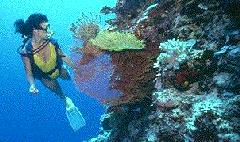First Aid for CORAL CUTS

For minor cuts, gently pull the edges of the skin open and remove embedded coral either by rinsing or using tweezers. Scrub directly inside the cut with clean gauze or a cloth soaked in clean, fresh water. Press on the wound to stop bleeding.
If bleeding persists, or the edges of a wound are jagged or gaping, the victim likely needs stitches. Taping a cut shut is often an effective alternative, but may leave a more visible scar than suturing. For more details on wound care, see Staph, Strep and General Wound Care. It is not true that using povidone-iodine or other iodine solutions to wash coral cuts will cause coral to grow in the wound. Coral is a marine animal; it can never grow inside the human body.
A popular local treatment for coral cuts is to urinate on the wound. This may sometimes wash broken pieces of coral from the cut, but urine discharges nematocysts in Australians box jellyfish. Thus, urine may make the injury worse.
For large cuts, fever, or any other signs of infection or illness after coral contact, see a doctor.
